Amstrad is a British electronics company. As of 2006, Amstrad's main business is manufacturing Sky UK interactive boxes.

The Tandy 1000 was the first in a line of IBM PC compatible home computer systems produced by the Tandy Corporation for sale in its Radio Shack and Radio Shack Computer Center chains of stores.

The Apple IIe Card is a compatibility card which allows compatible Macintosh computers to run software designed for the Apple II series of computers. Released in March 1991 for use with the LC family, Apple targeted the card at its widely dominated educational market to ease the transition from Apple II-based classrooms, with thousands of entrenched educational software titles, to Macintosh-based classrooms.
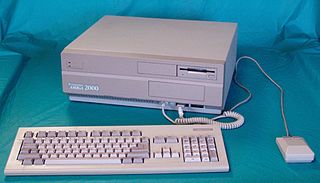
The Amiga 2000, or A2000, is a personal computer released by Commodore in March 1987. It was introduced as a "big box" expandable variant of the Amiga 1000 but quickly redesigned to share most of its electronic components with the contemporary Amiga 500 for cost reduction. Expansion capabilities include two 3.5" drive bays and one 5.25" bay that can be used by a 5.25" floppy drive, a hard drive, or CD-ROM once they became available.

The Macintosh II is a personal computer designed, manufactured and sold by Apple Computer, Inc. from March 1987 to January 1990. It is the first model of the Macintosh II family, and the first Macintosh to support a color display. When first introduced, a basic system with 20 MB drive and monitor cost US$5,498. With a 13-inch color monitor and 8-bit display card the price was around US$7,145. This price placed it in competition with workstations from Silicon Graphics, Sun Microsystems, and Hewlett-Packard.

The Power Macintosh G3 is a series of personal computers designed, manufactured, and sold by Apple Computer, Inc. from November 1997 to August 1999. It represented Apple's first step towards eliminating redundancy and complexity in the product line by replacing eight Power Macintosh models with three: Desktop and Mini Tower models for professional and home use, and an All-In-One model for education. The introduction of the Desktop and Mini Tower models coincided with Apple starting to sell build-to-order Macs directly from its web site in an online store, which was unusual for the time as Dell was the only major computer manufacturer doing this. Apple's move to build-to-order sales of the Power Macintosh G3 also coincided with the acquisition of Power Computing Corporation, which had been providing telephone sales of Macintosh clones for more than two years.
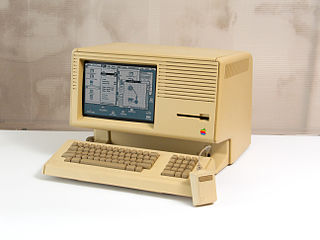
The Macintosh XL is a modified version of the Apple Lisa personal computer made by Apple Computer, Inc. In the Macintosh XL configuration, the computer shipped with MacWorks XL, a Lisa program that allowed 64 K Macintosh ROM emulation. An identical machine was previously sold as the Lisa 2/10 with the Lisa OS only.

The PowerBook G3 is a series of laptop Macintosh personal computers designed, manufactured and sold by Apple Computer, Inc. from 1997 to 2001. It was the first laptop to use the PowerPC G3 (PPC740/750) series of microprocessors, and was marketed as the fastest laptop in the world for its entire production run. The PowerBook G3 was succeeded by the PowerBook G4.
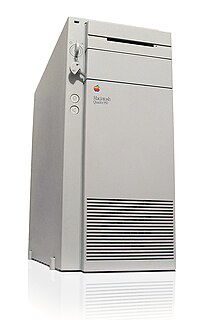
The Macintosh Quadra 950 is a personal computer designed, manufactured and sold by Apple Computer, Inc. from March 1992 to October 1995. It replaced the Quadra 900 that was introduced several months earlier, increasing the CPU clock rate of its 68040 CPU from 25 MHz to 33 MHz, and improving the graphics support. The two computers were otherwise identical, including the price. With a Macintosh Processor Upgrade Card installed, this computer is known as the Power Macintosh 950.

The Power Macintosh 6100 is a personal computer designed, manufactured and sold by Apple Computer, Inc. from March 1994 to March 1996. It is the first computer from Apple to use the new PowerPC processor created by IBM and Motorola. The low-profile ("pizza-box") case was inherited from the Centris/Quadra 610 and 660AV models, and replaced the Macintosh Quadra series that used the Motorola 68040 processor, Apple's previous high-end workstation line.

Applied Engineering, headquartered in Carrollton, TX, was a leading third-party hardware vendor for the Apple II series of computers from the early 1980s until the mid-1990s.
The Apple Network Server (ANS) is a line of PowerPC-based server computers designed, manufactured and sold by Apple Computer, Inc. from February 1996 to April 1997. It was codenamed "Shiner" and originally consisted of two models, the Network Server 500/132 and the Network Server 700/150, which got a companion model, the Network Server 700/200 with a faster CPU in November 1996. They are not a part of the Apple Macintosh line of computers; they were designed to run IBM's AIX operating system and their ROM specifically prevented booting the classic Mac OS. This makes them the last non-Macintosh desktop computers made by Apple to date. The 500/132, 700/150, and 700/200 sold in the U.S. market for $11,000, $15,000 and $19,000, respectively.

The Macintosh Quadra 605 is a personal computer designed, manufactured, and sold by Apple Computer, Inc. from October 1993 to July 1996. The model names reflect a decision made at Apple in 1993 to follow an emerging industry trend of naming product families for their target customers – Quadra for business, LC for education, and Performa for home. Accordingly, the Performa 475 and 476 was sold in department stores and electronics stores such as Circuit City, whereas the Quadra was purchased through an authorized Apple reseller.
The Amiga computer can be used to emulate several other computer platforms, including legacy platforms such as the Commodore 64, and its contemporary rivals such as the IBM PC and the Macintosh.
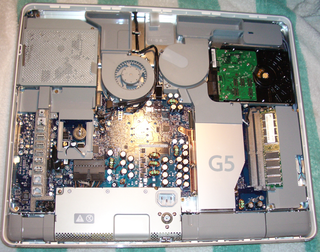
Hardware of the Macintosh is produced solely by Apple Inc., who determines internal systems, designs, and prices. Apple directly sub-contracts hardware production to external OEM companies, maintaining a high degree of control over the end product. Apple buys certain components wholesale from third-party manufacturers. The current Mac product family uses Intel x86-64 processors. All Mac models ship with at least 1 GB RAM as standard. Current Mac computers use AMD Radeon or nVidia GeForce graphics cards and may include a dual-function DVD and CD burner, called the SuperDrive. Macs include two standard data transfer ports: USB and Thunderbolt. USB was introduced in the 1998 iMac G3 and is ubiquitous today; Thunderbolt is intended for high-performance devices such as external graphics cards.
A compatibility card is an expansion card for computers that allows it to have hardware emulation with another device. The most popular of these were for Macintosh systems that allowed them to emulate Windows PCs via NuBus or PCI. Apple Computer made many of these cards (including a compatibility card for the Apple IIe. Later, Orange Micro made them, but by the end of the 1990s, greater application availability made such cards obsolete. Besides PC compatibility cards, others existed, such as the 3DO Blaster for PCs.
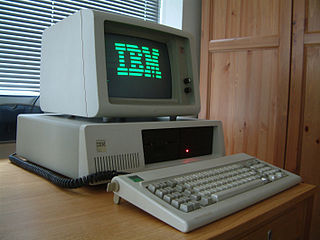
The IBM Personal Computer XT, often shortened to the IBM XT, PC XT, or simply XT, is a version of the IBM PC with a built-in hard drive. It was released as IBM Machine Type number 5160 on March 8, 1983. Apart from the hard drive, it was essentially the same as the original PC, with only minor improvements. The XT was mainly intended as an enhanced IBM PC for business users. Later floppy-only models would effectively replace the original model 5150 PC. A corresponding 3270 PC featuring 3270 terminal emulation was released later in October 1983. XT stands for eXtended Technology.

The Macintosh LC is a personal computer designed, manufactured, and sold by Apple Computer, Inc. from October 1990 to March 1992.

























